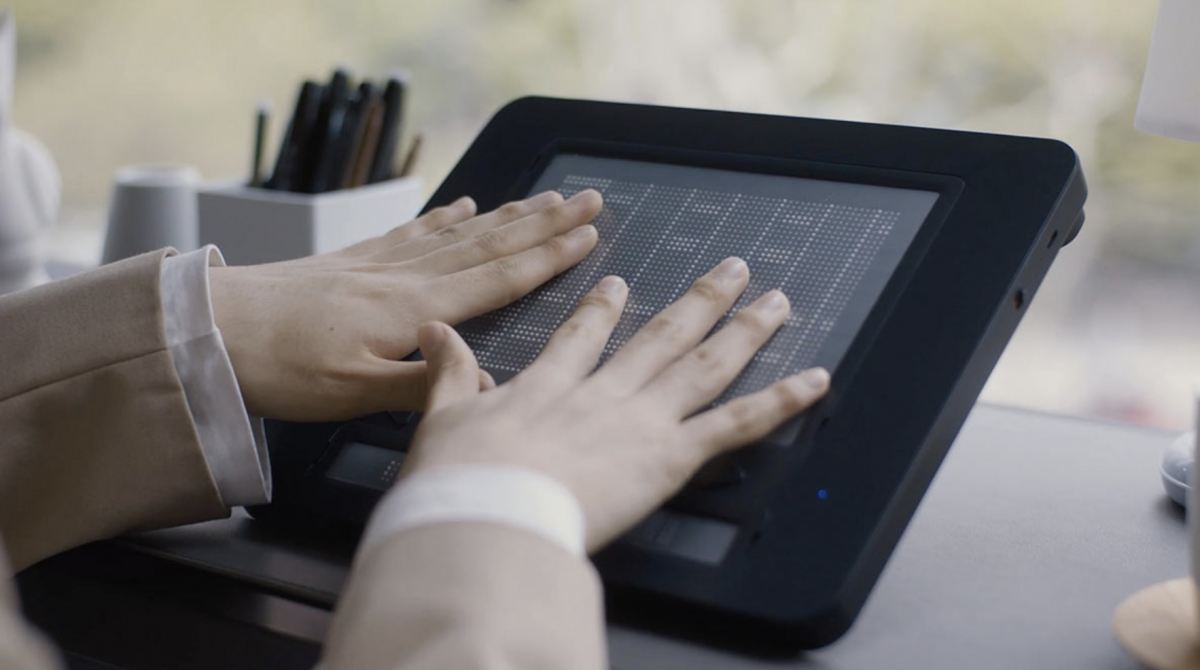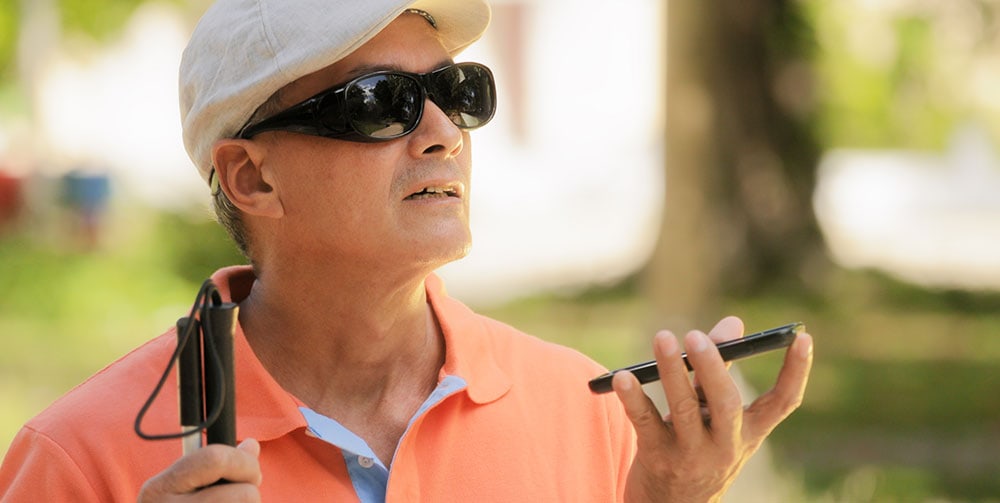Explore Advanced Glasses for the Visually Impaired and Their Benefits
Explore Advanced Glasses for the Visually Impaired and Their Benefits
Blog Article
An Overview to Life-altering Assistive Modern Technology for the Blind and Aesthetically Damaged
The innovation of assistive technology has actually introduced a transformative period for people that are aesthetically impaired or blind, offering devices that enhance autonomy and improve daily experiences. Developments such as clever navigating devices and AI-driven applications are redefining how users connect with their surroundings, while available reading options and clever home technologies assure to additional boost the lifestyle. As these innovations continue to progress, one should consider not just their performances however likewise their influence on promoting freedom and inclusivity. What does this mean for the future of access?
Smart Navigation Tools
Smart navigation tools are changing the way individuals who are blind or aesthetically damaged engage with their atmosphere. These advanced modern technologies, which incorporate GPS, audio feedback, and haptic signals, supply customers with important details regarding their surroundings, improving their independence and flexibility.
One prominent instance is making use of smart walking canes outfitted with sensing units that identify challenges and provide real-time responses via resonances or audio cues. These devices permit individuals to browse complicated settings, such as busy streets or crowded public rooms, with enhanced self-confidence. In addition, wearable gadgets, such as clever glasses, are being established to aid in acknowledging faces, reviewing text, and identifying things, better augmenting the individual's spatial recognition.
Additionally, wise navigation tools are increasingly integrating man-made knowledge to assess data and adapt to users' preferences. This individualized strategy not only improves navigation performance but likewise cultivates a sense of empowerment among users. As innovation remains to advance, the potential for smart navigating tools to produce a much more easily accessible and comprehensive world for people that are visually impaired or blind continues to be appealing, ultimately reshaping their daily experiences and communications.
Cutting-edge Mobile Applications
Mobile applications are arising as powerful devices for assisting people who are blind or visually impaired, providing a series of performances that enhance daily living. These applications harness advanced modern technology to help with day-to-day jobs, enhance access, and promote self-reliance.
One classification of cutting-edge mobile applications concentrates on visual recognition. Applications like Be My Eyes link customers with sighted volunteers via video clip calls, making it possible for real-time support for tasks such as checking out labels or browsing unknown settings. Apps like Seeing AI make use of fabricated intelligence to describe environments, read message, and recognize things, supplying customers with critical information at their fingertips.
An additional substantial location is navigating and orientation. Applications such as Aira and Neighboring Explorer give audio guidance, assisting users navigate metropolitan rooms easily. They provide personalized support, permitting a much more positive expedition of the environment.
Furthermore, health and health applications cater to particular needs, such as medication management and health and fitness tracking. These applications aim to cultivate an alternative strategy to health, making sure that individuals can maintain their wellness separately.
Wearable Assistive Tools
Wearable assistive devices stand for a significant development in innovation made to sustain individuals who are blind or visually damaged. These tools improve wheelchair and independence by supplying real-time feedback regarding the surrounding atmosphere. Amongst one of the most significant wearable modern technologies are smart glasses furnished with sensing units and video cameras, which can recognize obstacles and relay important details via sound hints.

Another cutting-edge choice includes wrist-worn gadgets that use ultrasonic waves to identify challenges and supply navigational aid. These devices typically feature adjustable settings, enabling users to tailor the signals to their details needs.
The assimilation of expert system in wearable assistive modern technology is additionally significant, as it continually enhances the accuracy and responsiveness of these tools. Overall, wearable assistive devices are transforming the lives of the blind and aesthetically damaged, fostering better freedom and improving high quality of life through cutting-edge services.
Available Reviewing Solutions
Obtainable reading options play a critical function in enabling people that are aesthetically damaged or blind to engage with text throughout numerous styles. These remedies incorporate a series of tools and technologies created to enhance reading experiences, from traditional print products to electronic content.
One popular solution is Optical Character Recognition (OCR) technology, which transforms printed text into digital format, enabling users to pay attention to or read the web content utilizing screen viewers. In addition, specialized e-readers equipped with text-to-speech abilities use customizable analysis experiences, allowing individuals to readjust font sizes and history shades navigate to this website for boosted presence.
One more effective approach is braille displays, which give tactile comments by converting electronic message into braille. This permits people to go through touch, promoting greater self-reliance and accessibility to literary works. In addition, mobile applications developed for checking out scanned papers or books can equip users with instantaneous accessibility to a huge collection of products.

Smart Home Technologies
Smart home modern technologies have revolutionized the method individuals that are blind or visually impaired interact with their living settings, improving both self-reliance and safety. These cutting-edge solutions take advantage of automation and connection to develop an accessible living room customized to the needs of individuals.
Smart speakers and voice-activated assistants provide hands-free control over numerous tools, allowing users to adjust safety, lights, and temperature procedures through basic voice commands. This functionality decreases dependence on sighted aid and promotes a sense of autonomy. Additionally, smart lighting systems can be tailored to deliver acoustic feedback or tactile signs, allowing people to browse their homes better.
Furthermore, security systems furnished with wise electronic cameras and sensing units can send out real-time alerts to individuals, improving individual safety without demanding visual confirmation. Automated door locks supply assurance, allowing customers to safeguard their homes easily.
Integrating wise home technologies not only improves everyday living but additionally motivates social interaction via attached gadgets - Voice-activated assistive devices. With continuous improvements in assistive innovation, the future shows up promising, as even more remedies will emerge to additional equip people who are visually damaged or blind, ensuring an extra independent and comprehensive way of life
Verdict
To conclude, the advancements in assistive innovation for the blind and aesthetically impaired represent a substantial leap toward improving self-reliance and high quality of life. Smart navigation devices, cutting-edge mobile applications, wearable gadgets, accessible reading remedies, and smart home innovations jointly promote an inclusive environment. This combination of modern technology not just enhances mobility and daily living but unbreakable reading glasses additionally equips individuals to engage completely with their surroundings, advertising better autonomy and engagement in culture.
Technologies such as wise navigating tools and AI-driven applications are redefining exactly how individuals connect with their surroundings, while obtainable reading solutions and wise home technologies assure to additional raise the quality of life. As innovation proceeds to advance, the possibility for clever navigation devices to create an extra comprehensive and available globe for people that are visually damaged or blind continues to be promising, eventually reshaping their day-to-day experiences and communications.
Wearable assistive devices represent a significant improvement in innovation created to sustain people that are blind or aesthetically damaged. Among the most noteworthy wearable modern technologies are clever glasses equipped with video eye center near me cameras and sensing units, which can recognize obstacles and relay important info via sound signs.
Smart navigation tools, innovative mobile applications, wearable tools, accessible analysis options, and smart home modern technologies jointly cultivate an inclusive atmosphere.
Report this page